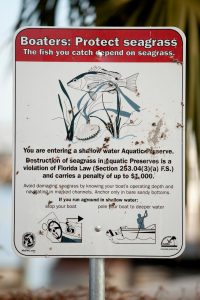Where is the Seagrass?
 The Extension Office has received several calls from boaters with a concern about the changes in large seagrass areas that seem to be “gone”, showing only sandy patches where it used to be a good seagrass ground. Also, they report a great abundance of sea urchins in the same areas.
The Extension Office has received several calls from boaters with a concern about the changes in large seagrass areas that seem to be “gone”, showing only sandy patches where it used to be a good seagrass ground. Also, they report a great abundance of sea urchins in the same areas.
In consultation with numerous specialists from the Big Bend Seagrass Aquatic Preserve (BBSGAP)( https://floridadep.gov/rcp/aquatic-preserve/locations/big-bend-seagrasses-aquatic-preserve), University of Florida, and Nature Coast Biological Station (NCBS), and FWC agents, they agree a series of events might produce this seagrass loss situation:
- Days with long negative tides that exposed large areas of seagrass that desiccated under the air and sun,
- Extreme cold weather during the last months that also affected seagrass leaves.
- Environmental conditions promoted a population explosion of sea urchins. They graze (feed) on seagrass leaves to the point where leaves coverage might be completely gone.
Good news
 Despite this situation, there is good news. Dr. Savanna Barry (https://www.flseagrant.org/faculty-and-staff/savanna-barry/) states: “Overall, turtle grass is extremely resilient and can survive 100% defoliation as long as conditions go back to being good soon after the event that caused them to drop leaves (low salinity, desiccation, grazing). However, two total defoliations (from desiccation and again from urchins) could be a bad combo. Especially for grass that is near the northern extent of its range in winter. However, if there are still live rhizomes below the surface, there is a good chance that they can recover even from two defoliation events”.
Despite this situation, there is good news. Dr. Savanna Barry (https://www.flseagrant.org/faculty-and-staff/savanna-barry/) states: “Overall, turtle grass is extremely resilient and can survive 100% defoliation as long as conditions go back to being good soon after the event that caused them to drop leaves (low salinity, desiccation, grazing). However, two total defoliations (from desiccation and again from urchins) could be a bad combo. Especially for grass that is near the northern extent of its range in winter. However, if there are still live rhizomes below the surface, there is a good chance that they can recover even from two defoliation events”.
This type of event has been recorded for the area in the past. Scientists have seen the seagrass recover from it. Scientists and agencies are aware of the situation and will keep an eye on this to follow up in the seagrass recovery. How fast will it recover? We don’t know as it depends on numerous environmental variables. However, we are lucky to be in a pristine and well-preserved area. We will post more information about this situation. Thank you to all those boaters, visitors, and local captains who reported this issue!!
 0
0
